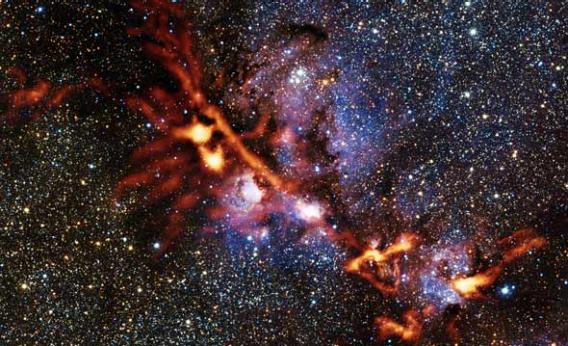Create a free profile to get unlimited access to exclusive videos, sweepstakes, and more!
The Celestial Fog Comes on Little Cat Feet

Deep in the heart of the constellation of Scorpius, star formation regions litter space. These clouds of gas and dust are collapsing, birthing stars left and right. We see so many in this direction because weâre looking toward the center of our Milky Way galaxy; itâs like looking downtown and seeing more activity in that direction.
One of these clouds, at a distance of more than 5,000 light-years from Earth, is called the Catâs Paw nebula. When you use a âregularâ telescope that sees in visible light, as our eyes do, the hydrogen gas glows in patches, resembling the bottoms of our household petsâ feet. But when you look in the submillimeter, wavelengths of light well outside what our eyes can see, the dust that is opaque and black in visible light comes alive, like a fire strewn through a network of dark caverns:
This view is from the Atacama Pathfinder EXperiment (APEX) telescope, located in the high desert in Chile. At an elevation of a staggering (literally) 5,100 meters (16,700 feet), the air is so thin that the 'scope is literally above most of the atmosphere. Thatâs good, because water vapor in the air strongly absorbs light with submillimeter wavelengths; to a telescope like APEX a little bit of moisture in the air might as well be a steel lid across the observatory.
A new camera, called Artemis, has just been installed on APEX, and this is one of the first images it took. Artemis is a fairly advanced camera, able to see larger swaths of the submillimeter sky than cameras have before it. Affixed to APEX, it provides amazing sensitivity and field of view.
The shot of the Catâs Paw is pretty amazing. In general, objects emit light depending on their temperature: Something very hot (like a star) will emit light with shorter wavelengths and be bright. Colder objects (like the dust in the Catâs Paw) will emit much longer wavelength light and be faint. The dust seen by Artemis in the Catâs Paw is beyond cold; it glows at a chilly 8 Kelvinâminus 265 degrees Celsius or minus 445 degrees Fahrenheit, just a few degrees above absolute zero. Dust like this chokes star-forming clouds, which we usually see in visible light as dark lanes and filaments strewn across them. But to Artemis, they are like flames in the interstellar canvas.
The Artemis observations have been superposed on the stars and gas seen by the European Southern Observatoryâs VISTA telescope, which views the skies in infrared, just outside what our eyes can see. In it, you can just see a couple of the soap-bubble features in the Catâs Paw, places where the furious light and winds from young, massive stars have compressed the gas around them, snow-plowing it into thin spherical shells light-years across. The forces at work here are huge and fierce; baby stars are a tempestuous lot.
Because the Catâs Paw is a good example of a large, nearby stellar nursery, itâs a favorite target for astronomers. Not long ago, it was observed using the space-based telescopes Herschel and Spitzer, as well as the ground-based NEWFIRM infrared telescope:
That image is in the far-infrared, where warmer dust glows (shown in green). The bright red and orange spots are newly born massive stars, and as you can see, they form along that long filament seen in the APEX image. Dense dust is where new stars are born! Thatâs not obvious in either the near-infrared or submillimeter images alone. But when you combine the power of telescopes that see across the electromagnetic spectrum, much more of the real Universe becomes clear.
And the Catâs Paw isnât done yet. The thick clots of dust seen by Artemis and the other observatories is an indication that there is more material from which stars can be woven, and that the nebula will make many more before its day is done.
Artemis is new, and still being tested. The image above is a down payment on the science it promises, and clearly, what it will certainly be able to deliver.


























